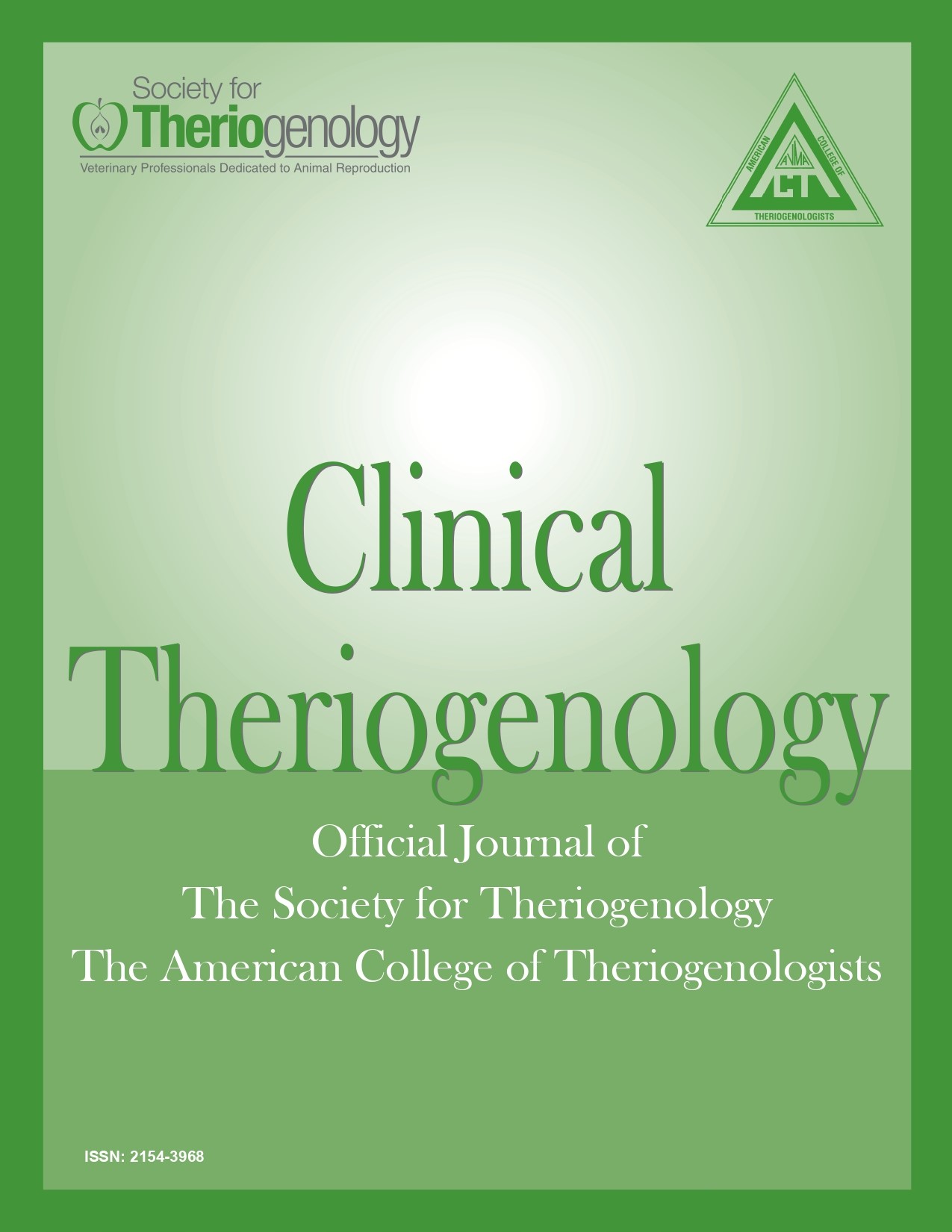Effect of human chorionic gonadotropin treatment on the duration of oxytocin-induced prolonged corpus luteum function in mares
Abstract
Oxytocin is used increasingly in mares to prolong corpus luteum (CL) function to suppress estrus. When mares develop prolonged CL function in response to oxytocin treatment, the CL generally remains functional for 60–90 days. However, a longer duration of CL function can make this method of estrus suppression even more clinically useful. We hypothesized that human chorionic gonadotropin (hCG) treatment during the period of oxytocin-induced prolonged CL function would extend the duration of CL function (i.e. beyond 90 days). Prolonged CL function was induced in mares (n = 14) by treating them with 60 units of intramuscular oxytocin once daily on days 7–14 after ovulation. Mares were then randomly assigned equally to a control group that received no additional treatment and an hCG-treated group that received 2,500 units of intramuscular hCG on days 30, 45, 60, 75, and 90 after ovulation. Jugular blood samples were collected for progesterone concentration determination on the day of ovulation and then 3 times (M, W, and F) weekly for 120 days. Duration of CL function was not different (p > 0.05) and it was 78.0 ± 7.5 and 91.4 ± 20.4 days (mean ± standard deviation [SD]) in control and hCG-treated mares, respectively. Therefore, hCG treatment (during the period of oxytocin-induced prolonged CL function) did not extend CL function, hence alternative methods should be explored.
Downloads
References
2. Keith L, Ball BA, Scoggin K, et al: Diestrus administration of oxytocin prolongs luteal maintenance and reduces plasma PGFM concentrations and endometrial COX-2 expression in mares. Theriogenology 2013;79:616–624. doi: 10.1016/j.theriogenology.2012.11.015
3. Rebordao MR, Galvao A, Pinto-Bravo P, et al: Endometrial prostaglandin synthases, ovarian steroids, and oxytocin receptors in mares with oxytocin-induced luteal maintenance. Theriogenology 2017;87:193–204. doi: 10.1016/j.theriogenology.2016.08.028
4. Vanderwall DK, Silvia WJ, Fitzgerald BP: Concentrations of oxytocin in the intercavernous sinus of mares during luteolysis: temporal relationship with concentrations of 13,14-dihydro-15-keto-prostaglandin F2α. J Reprod Fertil 1998;112:337–346. doi: 10.1530/jrf.0.1120337
5. Shand N, Irvine CHG, Turner JE, et al: A detailed study of hormonal profiles in mares at luteolysis. J Reprod Fertil 2000;Suppl 56:271–279.
6. Goff AK, Pontbriand D, Sirois J: Oxytocin stimulation of plasma 15-keto-13,14- dihydro prostaglandin F-2α during the oestrous cycle and early pregnancy in the mare. J Reprod Fertil 1987;Suppl 35:253–260.
7. Vanderwall DK, Parkinson K, Rigas J: How to use oxytocin treatment to prolong corpus luteum function for suppressing estrus in mares. J Equine Vet Sci 2016;36:1–4. doi: 10.1016/j.jevs.2015.09.007
8. Parkinson KC, Vanderwall DK, Rigas J, et al: Effect of chronic administration of oxytocin on corpus luteum function in cycling mares. J Equine Vet Sci 2020;90:102991. doi: 10.1016/j.jevs.2020.102991
9. Manning HS, Runcan EE, Dias de Moraes CR, et al: Using estrous behavior to time initiation of oxytocin administration to prolong luteal function in mares. J Equine Vet Sci 2019;75:78–81. doi: 10.1016/j.jevs.2019.01.012
10. Sarnecky BA, Vanderwall DK, Mason HM, et al: Evaluation of a proprietary slow-release oxytocin formulation on corpus luteum function in mares. J Equine Vet Sci 2019;77:28–30. doi: 10.1016/j.jevs.2019.01.004
11. Stabenfeldt GH, Hughes JP, Evans JW, et al. Spontaneous prolongation of luteal activity in the mare. Equine Vet J 1974;6:158–163. doi: 10.1111/j.2042-3306.1974.tb03952.x
12. Sarnecky BA, Vanderwall DK, Mason H, et al: Oxytocin-induced secretion of 13,14-dihydro-15-keto-prostaglandin F2α in mares with prolonged corpus luteum function. Clin Theriogenol. 2020;12:366.

This work is licensed under a Creative Commons Attribution-NonCommercial 4.0 International License.
Authors retain copyright of their work, with first publication rights granted to Clinical Theriogenology. Read more about copyright and licensing here.





